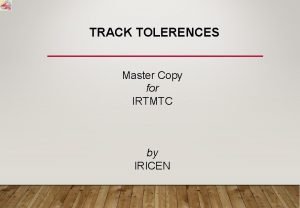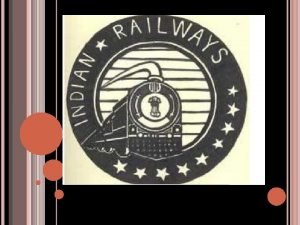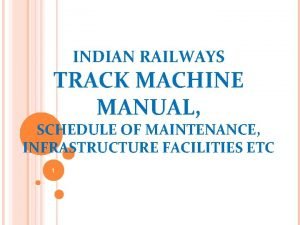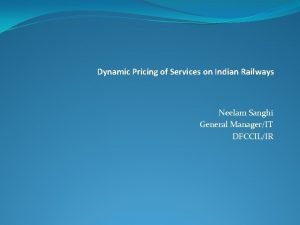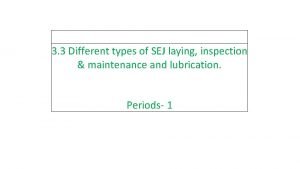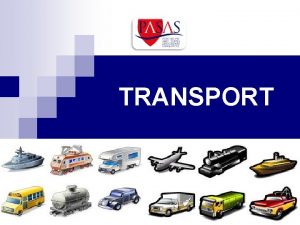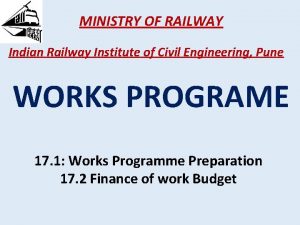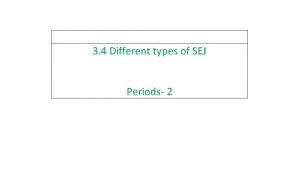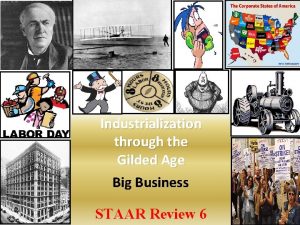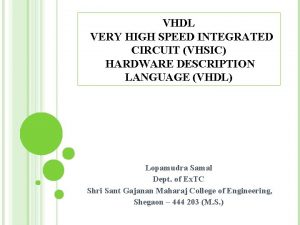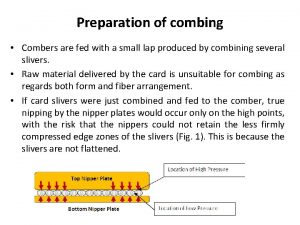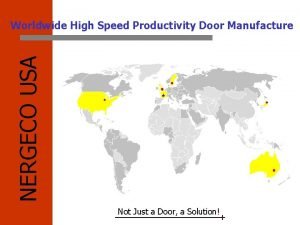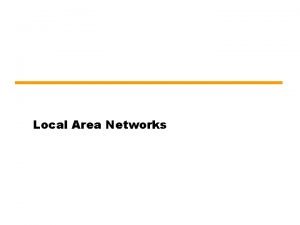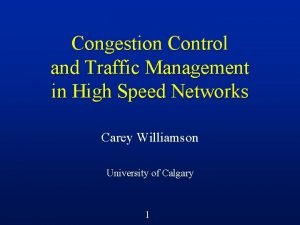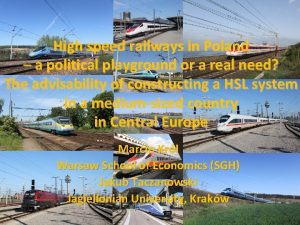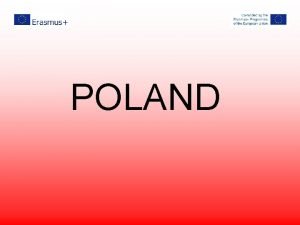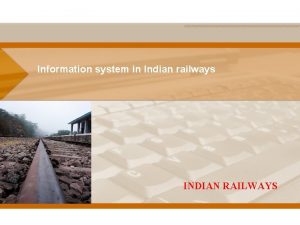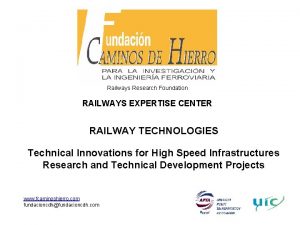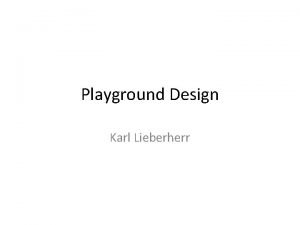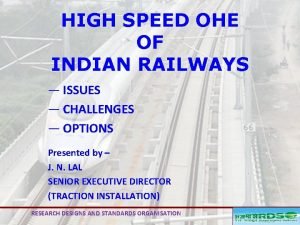High speed railways in Poland a political playground




















- Slides: 20

High speed railways in Poland – a political playground or a real need? The advisability of constructing a HSL system in a medium-sized country in Central Europe Marcin Król Warsaw School of Economics (SGH) Jakub Taczanowski Jagiellonian University, Kraków

High speed railways q High speed rail includes a complex reality involving various aspects: § Technical: infrastructure, rolling stock and operations § Cross-sector: financial, commercial, managerial and training issues (UIC) q High speed railways comprise: § Specially built High Speed lines equipped for speeds generally equal to or greater than 250 km/h § Specially upgraded High Speed lines equipped for speeds of 200 km/h § Specially upgraded High Speed lines which have special features as a result of topographical, relief or town-planning constraints, on which the speed must be adapted to each case (European Commission directive 96/48/EC appendix 1)

Poland – the first European country with HSL? Central Rail Line (Polish: Centralna Magistrala Kolejowa, CMK) (Warsaw-) Grodzisk Maz. – Psary (-Kraków) - Zawiercie (-Katowice) q Total length 223 km q Construction 1971 -77 (opening of the first section of the Direttissima Rome – Florence 24. 02. 1977 , TGV Paris – Lyon 22. 09. 1981) However § The first express train 3. 06. 1984 (140 km/h), § 160 km/h from 1988, § 200 km/h from 14. 12. 2014 q Technical parameters: § Maximum passenger train speed: 200 -250 km/h § Minimum curve radius: 4000 m § Steepest gradient: 6 per 1000

Central Rail Line Source: author’s own elaboration on the basis of: www. plk-sa. pl. Source: www. siskom. waw. pl.

Main rail connections in Poland Source: author’s own elaboration.

Pendolino trains in Poland q May 1994 – presentation of the ETR 460 train in Poland high speed trials on the Central Rail Line (CMK) 11. 05. 1994 – Central-European speed record of 250, 1 km/h was reached q 1997 – the first tender for fast trains with tilting mechanism q 1998 – FIAT Ferroviaria was declared the winner, but the Supreme Audit Office (NIK) cancelled the tender because of the poor financial situation of the PKP and lack of suitable infrastructure q 2008 – the second tender, this time for high speed trains without tilting mechanism q 2010 – Alstom was declared the winner q 2013 – arrival of the first of 20 ED 250 trains q 24. 11. 2013 – a new speed record was broken on the CMK (293 km/h) q 14. 12. 2014 – beginning of the commercial use

Photo Jakub Taczanowski

The rise of domestic rolling stock producers PESA in Bydgoszcz q Founded as Prussian railway workshops in 1851 q 2001 – new name and profile: rolling stock construction and not only repair and modernisation q 2001 – the first producer of modern railway motor carriages in Poland q 2004 – construction of the first electric units q 2006 – the first contract to Western Europe (Italy) q 2012 – the beginning of production of electric locomotives (Gama) q 2012 – contract for 470 diesel units for DB for 1. 2 billion euro q 2014 – the first long-distance electric units Dart with maximum speed of 200 km/h; 30. 05. 2015 – the speed record of 204 km/h was broken NEWAG in Nowy Sącz q Founded as Austrian railway workshops in 1876 q 2005 – new name and beginning of production of electric units q 29. 08. 2015 – speed record of rolling stock designed and constructed in Poland was broken by 45 WE Impuls electric unit - 225, 2 km/h

NEWAG 36 WE Impuls Photo Jakub Taczanowski

The recurring project of „Y” HSL Basic characteristics: q q q A completely new railway line from Warsaw to Poznań and Wrocław The old problem of the long Warsaw-Wrocław line – solved Central position of Łódź (with a new underground railway station) Total length of about 450 km Maximum speed of 350 km/h 25 k. V AC electrification system (not used in Poland so far) History: 2008 – PKP PLK S. A. launched a tender for a feasibility study 2010 – The agreement on feasibility study was signed with the winner 2011 – The minister of transport decided to postpone the project until 2030 2014 – Poland applied for the European Commission grants for transport, the „Y” HSL was included with the total cost of 7. 5 billion euros q 2014 – a contract for a feasibility study to prolong the „Y” HSL to Prague and Berlin was signed q q

The recurring project of „Y” HSL Source: PKP PLK S. A. Source: www. siskom. waw. pl.

Alternative projects for Warsaw – Wrocław route Source: author’s own elaboration. Sieradz – Wieruszów line: q A completely new railway line from Sieradz to Wieruszów (49 km) q Electrification and modernisation of 45 km of local lines q Costs about 1. 3 billion zł q Project abandoned in favour of the „Koniecpol prosthesis”: q Modernisation of the line Koniecpol – Opole (136 km) in order to reach a speed of 120 -140 km/h q A less expensive alternative to „Y” HSL q The first Pendolino train in 2014

Journey times Warsaw – Kraków line (Central Rail Line, 293 km) Transport mode Journey time Pendolino train 2 h 20 min Airplane 0 h 55 min + transfer (2 h) Bus 4 h 55 min Private car 4 h 07 min Warsaw – Wrocław line (397 km down the „Koniecpol prosthesis”) Transport mode Journey time Pendolino train 3 h 42 min „Y” high speed train 1 h 40 min Train via new Sieradz line 2 h 30 min Airplane 0 h 55 min + transfer (2 h) Bus 5 h 30 min Private car 3 h 41 min Source: author’s own elaboration based on: www. intercity. pl; http: //inforail. pl; www. e-podroznik. pl and google. pl

Financial sustainability considerations: Track access charges 6, 00 5, 58 Track access charge 500 gross tonne intercity train (EUR/train-km) in 2014 5, 35 5, 10 5, 00 4, 81 4, 40 4, 05 4, 01 2, 98 3, 00 2, 66 2, 51 2, 31 2, 12 2, 00 1, 81 1, 68 1, 54 1, 48 1, 39 1, 37 1, 20 1, 19 1, 00 0, 99 0, 90 0, 70 0, 61 0, 30 0, 00 DE LV FR* BE IE AT LT PL IT* ES** EE RO SK HU NL EL * 2013 ** average track access charge for HST running with speed limited to 260 km/h BG PT CZ UK LU SE FI SI DK Source: COM(2014) 353 final

Financial sustainability considerations: Fares Estimated average business class and leisure day return fare (EUR/km) 2013 1, 2 1, 01 1 0, 76 0, 8 0, 62 0, 6 0, 48 0, 45 0, 4 0, 33 0, 21 0, 2 0, 6 0, 13 0, 07 0, 13 0, 09 0, 26 0, 14 0, 07 0 Warsaw - Gdańsk Praha - Ostrava Warsaw - Cracow Lisboa - Porto IT HST (FS & NTV) FR HST (TGV) * * Business Class Leisure Source: COM (2014) 353 final; own calculation for Poland ES HST (AVE) DE HST (ICE) PBKA

Earnings disparity Monthly net earnings (EUR, 2014) Single person without children, 100% of average worker, calculated from Eurostat annual data 2500 2000 1679 1736 Spain Italy 2224 2233 France Belgium 2315 1500 1057 1000 634 726 500 0 Poland Czech Republic Source: Eurostat Portugal Germany

SWOT analysis for HSL Strenghts Weeknesses § Central Rail Line § Little experience in HSL construction § Pendolino trains § Controversies around „Y” HSL (project officially § A project of „Y” HSL Warsaw-Poznań/Wrocław postponed until 2030 in 2011) § The general organisational and financial situation of the PKP „Group” Opportunities Threats § Compact state territory § Air travel (bird fly) distance between Warsaw and all cities and urban areas over 300, 000 is not larger than 300 km (the only exception is Szczecin, 450 km) § An important southern urban axis Wrocław – Katowice – Kraków – Rzeszów with the total urban population over 5, 000 § Location at the „cross-roads” of Traneuropean railway lines § Rise of the Polish rolling stock producers – PESA and NEWAG § Large-scale neglects in the existing railway network of the country § The decreasing role of the railways in the Polish transport system § The general poor image of the railways in the conutry § The risk to block all investments in the rail infrastructure by launching the HSL project § Competition of low-cost long-distance bus companies § Low-cost domestic flights Source: author’s own elaboration.

Discussion q HSL project would be a completely new challenge for the PKP q Very high construction costs could block all other investments - not only in projected new lines (mainly connections with airports) but also maintenance of the existing network q HSL maintenance costs are particularly high – do we know anything about the chances to cover them in the long run - > rentability of HSL q How much are the potential customers ready to pay for shorter journeys? What is the price of time for Polish citizens? q HSL as a chance for the Polish railways and rolling stock manufacturers to leapfrog to the future? q HSL as a chance to boost the Polish economy

Conclusions q It is very difficult to evaluate the advisability of constructing a HSL in Poland q The potential opportunities are balanced by several significant threats and risks q Given the state of the railway infrastructure and rail transport in general, our intuition is to concentrate on the existing network by developing its potential (e. g. modernisation to the maximum speed of 200 km/h in the case of Warsaw-Poznań or fragments of Warsaw-Gdańsk lines) and by purchase of modern rolling stock (also from Polish manufacturers) q Should the HSL project be treated as a very important next step in Polish railways development?

Thank you for your attention!
 Passengers can help a driver better manage emotions by
Passengers can help a driver better manage emotions by Irtmtc
Irtmtc Indian railways monopoly
Indian railways monopoly Track machine manual 2020
Track machine manual 2020 What is dynamic pricing in railways
What is dynamic pricing in railways Sej types
Sej types Thank you for listening any questions
Thank you for listening any questions Irwcms measurement
Irwcms measurement Railway modified sej
Railway modified sej Distance formula speed time
Distance formula speed time Speed detection of moving vehicle using speed cameras ppt
Speed detection of moving vehicle using speed cameras ppt Low wages high rent political cartoon meaning
Low wages high rent political cartoon meaning Vhsic
Vhsic High speed combers
High speed combers Nergeco door troubleshooting
Nergeco door troubleshooting High speed lans
High speed lans Horse latitude
Horse latitude Ti high speed adc
Ti high speed adc High speed fpga design
High speed fpga design High speed traffic management
High speed traffic management Acn internet canada
Acn internet canada

